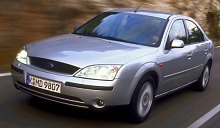 No
matter how brilliant the old Mondeo drove, it was not a commercial
success
anyway. Back in 1993, Ford announced in high profile that it spent some
record-breaking 6 billion US dollars in the Mondeo project - a world
car
that was going to be sold in most places as Mondeo and in the US as
Contour
or Mercury Mystique. It was dynamically brilliant but cramped for its
size
and lack of an attractive packaging. When it was replaced in late 2000,
most analysts doubt that any profit was generated throughout its life.
Ford learned the lesson: driver appeal alone doesn't sell. No
matter how brilliant the old Mondeo drove, it was not a commercial
success
anyway. Back in 1993, Ford announced in high profile that it spent some
record-breaking 6 billion US dollars in the Mondeo project - a world
car
that was going to be sold in most places as Mondeo and in the US as
Contour
or Mercury Mystique. It was dynamically brilliant but cramped for its
size
and lack of an attractive packaging. When it was replaced in late 2000,
most analysts doubt that any profit was generated throughout its life.
Ford learned the lesson: driver appeal alone doesn't sell.
Undoubtedly, the new Mondeo has been designed with the lesson learned in mind. No more big spending, especially considering the market for family sedan segment is down-sizing recent years. Technically conservative, using modified versions of the old suspensions, gearboxes and V6 engine. However, extra attention was paid to packaging, from the Passat-size cabin to Passat-like plastic and switch gear. According to those who saw it in real, it even looks very Passat alike. So, although Ford denied, the new Mondeo was designed with the Volkswagen rival used as benchmark. I don't like the styling, which is as angular as the old car organic. Odd headlamps, odd grille, odd C pillars ... however, chief designer J Mays said it would have been worse if not he and designer Chris Bird joined Ford some 2 years ago to change the final design. By the way, their resumes listed Volkswagen New Beetle and Audi's first A4 respectively, so you can hardly doubt that. Technical View Hard to imagine, now the new Mondeo is the biggest in class as it is a lot longer, wider and higher than the car it replaces. The 2754mm wheelbase is 50mm longer than before (which was already class-leading) and out-class everybody else convincingly (Passat is 2703mm while Peugeot 406 is 2700mm. Even the American Honda Accord is just 2715mm, no match with the Mondeo). Moreover, as the body shape is now more rectangular, it doesn't waste a lot of space like its predecessor. You can see its cabin as a Passat with more rear leg room. In other words, half a class larger than competitors bar Passat.
On the other hand, the Zetec engine family has been replaced by a new Duratec HE series which was mainly developed by Mazda (Ford's subsidiary) for the whole group. It features alloy head and block, a powerful 32-bit management system and a two-stage variable length intake manifold to improve torque curve - for example, the 2-litre version delivers 90% of peak torque from 2000 to 6000rpm. And the "peak torque" we say is a high 140 lbft. Peak power of 143 hp is also outstanding compare with most competitors. Although the new Mondeo has not yet employed VVT, it is sufficient to out-accelerate many 2-litre class rivals. 0-60 mph now takes 8.8 sec, an improvement of a full second from the old car, thanks to the new engine, effective weight control and shorter gearing. The 5-speed manual is still the old MTX-75 except with revised gearing and a cable-operated shift mechanism, the former was made possible because the engine is much quieter at high rev than the old rough Zetec, the latter improves shift quality. 4-speed automatic is unchanged. Top model still employs the 168 hp 2.5-litre Duratec V6 (also all-alloy) with little revision to make it comply with new emission regulations come effective in 2005. Suspensions were carried over from the old car. However, the front MacPherson struts are mounted on redesigned sub-frame while the rear multi-link has more travel and new bushing. On The Road The new Mondeo really feels a lot more refined, something approaching German premier cars. The engine is quite smooth (if not class-leading) and quiet, torquey from low rev. Acceleration is satisfying, especially gearshift is precise and crisp. Braking has been improved as well, thanks to larger discs (300mm up front and 280mm at the back) and improved pedal feel which makes light braking smoother. In terms of handling and ride, the rigid chassis and tuned suspensions deliver a grown-up feel by its fluent control in bends and the way it absorb bumps, although the extra size inevitably make it less flickable on tight B-roads. Like BMW, Mercedes and Audi, the Mondeo's new suspensions are tuned to offer better high-speed damping with a bit trade-off in low-speed bump absorption. This make it less floaty on most roads and very composed at higher speed. You'll feel it rides firmer than before, but overall ride quality is actually improved, partly thanks to the rigid body. Make it clear, the new Mondeo has beaten our long-time Champion Peugeot 406 in terms of handling. It steers with wonderful precision and feedback, adequate weighting and little kickback. Sharper and more linear than 406 at the limit. Moreover, its cornering limit is higher, that is, resists understeering better. Far better gearshift and sharper throttle response as well. In The Cabin
Look aside, the new Mondeo is extremely desirable. Volkswagen Passat is still the best built, but it can't quite touch Mondeo's dynamic. Peugeot 406, on the other hand, loses in all areas to the Mondeo except styling. So a new Champion has been born. What a pity the
new Mondeo
is no longer a world car as its predecessor used to be. It won't be on
sale in North America although I do think its big cabin actually favour
this market. Ford expect to build 350,000 units annually in the Genk
plant
of Belgium. |
| The above report was last updated on 20 Feb 2001. All Rights Reserved. |
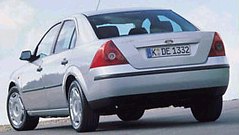 Better
still is that the massive increase of size added just 25 kg to the
overall
weight of the 2.0 Ghia model despite that the chassis is 60% stronger
in
torsion. Aluminium engine block accounts for 18 kg among all weight
control
measures taken.
Better
still is that the massive increase of size added just 25 kg to the
overall
weight of the 2.0 Ghia model despite that the chassis is 60% stronger
in
torsion. Aluminium engine block accounts for 18 kg among all weight
control
measures taken. 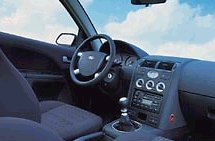 Large
and comfortable aside, the new Mondeo shines in visual build quality.
Dashboard
is made of soft-touch plastic approaching, if not exactly matching, the
quality of Volkswagen. In other words, feels more prestige than anyone
else. There's also some niche details, such as the chromed rims
surrounding
gauges and the four spokes of steering wheel in silver color. Many
switches
and grab handles are made with damped feel.
Large
and comfortable aside, the new Mondeo shines in visual build quality.
Dashboard
is made of soft-touch plastic approaching, if not exactly matching, the
quality of Volkswagen. In other words, feels more prestige than anyone
else. There's also some niche details, such as the chromed rims
surrounding
gauges and the four spokes of steering wheel in silver color. Many
switches
and grab handles are made with damped feel. 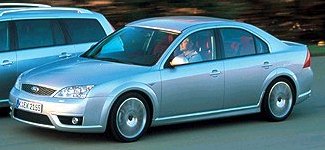 It
is still quite unbelievable that today’s European Ford is the same
company
as when it produced Escort and Sierra. Since the first Mondeo, then
Puma,
Ka, facelifted Fiesta, Focus and today’s Mondeo, Ford has successfully
changed its image from econo cars to exciting cars. However, Ford did
not
forget that its root is still based on affordable prices and
accessibility.
Therefore it will never produce something as expensive as M3 or as
uncompromising
as MG ZR160.
It
is still quite unbelievable that today’s European Ford is the same
company
as when it produced Escort and Sierra. Since the first Mondeo, then
Puma,
Ka, facelifted Fiesta, Focus and today’s Mondeo, Ford has successfully
changed its image from econo cars to exciting cars. However, Ford did
not
forget that its root is still based on affordable prices and
accessibility.
Therefore it will never produce something as expensive as M3 or as
uncompromising
as MG ZR160.
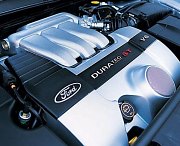 Perhaps
we were fooled by the aggressive look of the ST220. It has massive air
dams front and rear, fashionable mesh grille and flared wheelarches
filling
with 18-inch alloy wheels. Yes, really 18-inch. It seems that Ford
chose
such an unusually large wheel purely for look, because the brakes of
ST220
are unchanged from standard Mondeo (although 300mm front and 280mm rear
are not considered small either). All these ingredients contribute to
an
image of mind-blowing performance. However, if you consider
power-to-weight
ratio (220hp pulling 1460kg), you will get a clearer picture that the
ST220
is actually a warm performance saloon.
Perhaps
we were fooled by the aggressive look of the ST220. It has massive air
dams front and rear, fashionable mesh grille and flared wheelarches
filling
with 18-inch alloy wheels. Yes, really 18-inch. It seems that Ford
chose
such an unusually large wheel purely for look, because the brakes of
ST220
are unchanged from standard Mondeo (although 300mm front and 280mm rear
are not considered small either). All these ingredients contribute to
an
image of mind-blowing performance. However, if you consider
power-to-weight
ratio (220hp pulling 1460kg), you will get a clearer picture that the
ST220
is actually a warm performance saloon.